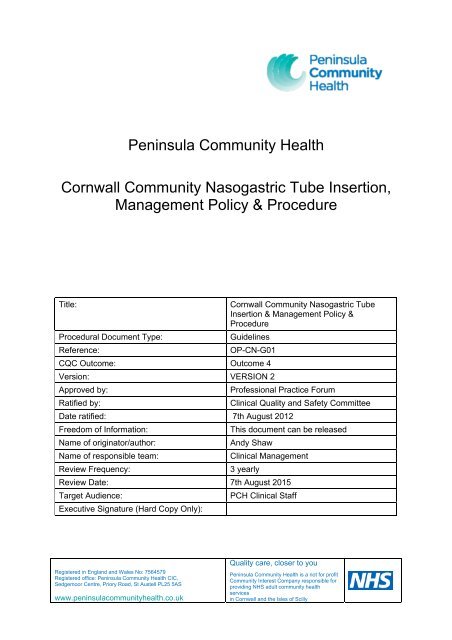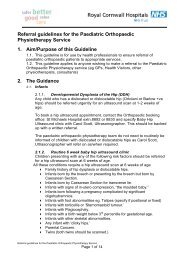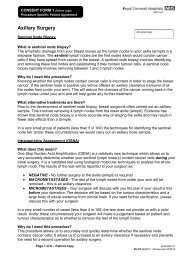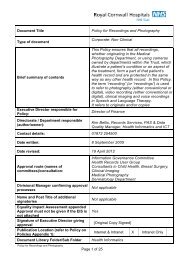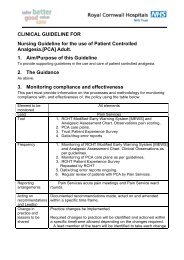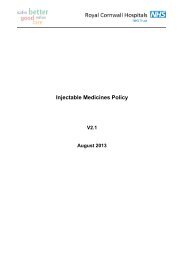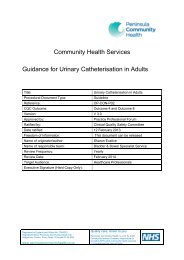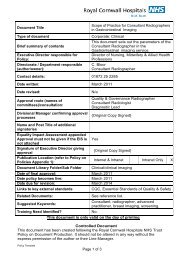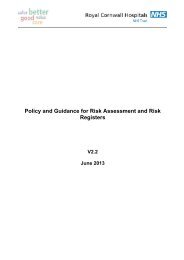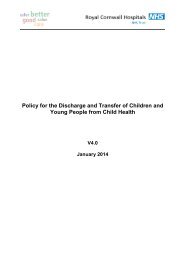Cornwall Community Nasogastric Tube Insertion & Management ...
Cornwall Community Nasogastric Tube Insertion & Management ...
Cornwall Community Nasogastric Tube Insertion & Management ...
You also want an ePaper? Increase the reach of your titles
YUMPU automatically turns print PDFs into web optimized ePapers that Google loves.
Peninsula <strong>Community</strong> Health<br />
<strong>Cornwall</strong> <strong>Community</strong> <strong>Nasogastric</strong> <strong>Tube</strong> <strong>Insertion</strong>,<br />
<strong>Management</strong> Policy & Procedure<br />
Title: <strong>Cornwall</strong> <strong>Community</strong> <strong>Nasogastric</strong> <strong>Tube</strong><br />
<strong>Insertion</strong> & <strong>Management</strong> Policy &<br />
Procedure<br />
Procedural Document Type: Guidelines<br />
Reference: OP-CN-G01<br />
CQC Outcome: Outcome 4<br />
Version: VERSION 2<br />
Approved by: Professional Practice Forum<br />
Ratified by: Clinical Quality and Safety Committee<br />
Date ratified: 7th August 2012<br />
Freedom of Information: This document can be released<br />
Name of originator/author: Andy Shaw<br />
Name of responsible team: Clinical <strong>Management</strong><br />
Review Frequency: 3 yearly<br />
Review Date: 7th August 2015<br />
Target Audience:<br />
Executive Signature (Hard Copy Only):<br />
PCH Clinical Staff<br />
Registered in England and Wales No: 7564579<br />
Registered office: Peninsula <strong>Community</strong> Health CIC,<br />
Sedgemoor Centre, Priory Road, St Austell PL25 5AS<br />
www.peninsulacommunityhealth.co.uk<br />
Quality care, closer to you<br />
Peninsula <strong>Community</strong> Health is a not for profit<br />
<strong>Community</strong> Interest Company responsible for<br />
providing NHS adult community health<br />
services<br />
in <strong>Cornwall</strong> and the Isles of Scilly
Contents<br />
1 Introduction ..........................................................................................................2<br />
2 Definitions ............................................................................................................2<br />
3 Duties...................................................................................................................2<br />
4 Policy Statement..................................................................................................2<br />
5 Purpose ...............................................................................................................2<br />
6 Right decision & Risk Assessment ......................................................................3<br />
7 <strong>Nasogastric</strong> <strong>Tube</strong> insertion ..................................................................................3<br />
7.1 Equipment ....................................................................................................3<br />
7.2 <strong>Tube</strong> measurement ......................................................................................3<br />
7.3 <strong>Tube</strong> insertion Action & Rationale ................................................................4<br />
7.4 Fine bore feeding tubes................................................................................5<br />
7.5 Securing the tube .........................................................................................6<br />
8 Ongoing Care and <strong>Management</strong> of <strong>Tube</strong> once confirmed in Situ ........................6<br />
9 Managing tube in patients home..........................................................................7<br />
10.1 Family involvement .....................................................................................7<br />
10.2 District Nurse <strong>Management</strong> ........................................................................7<br />
10 Trouble shooting ..................................................................................................7<br />
11 Risk <strong>Management</strong> Strategy Implementation ........................................................8<br />
11.1 Implementation & Dissemination ...........................................................8<br />
11.2 Training and Support.............................................................................8<br />
11.3 Document Control & Archiving Arrangements .......................................8<br />
11.4 Equality Impact Assessment .................................................................8<br />
12 Process for Monitoring Effective Implementation.................................................9<br />
13 References ..........................................................................................................9<br />
Please Note the Intention of this Document<br />
The procedures described below are intended to support staff in complying with the stated<br />
Peninsula <strong>Community</strong> Health policy and to ensure the care is safe and effective.<br />
Review and Amendment Log<br />
Version No Type of Change Date Description of change<br />
Registered in England and Wales No: 7564579<br />
Registered office: Peninsula <strong>Community</strong> Health CIC,<br />
Sedgemoor Centre, Priory Road, St Austell PL25 5AS<br />
www.peninsulacommunityhealth.co.uk<br />
Quality care, closer to you<br />
Peninsula <strong>Community</strong> Health is a not for profit<br />
<strong>Community</strong> Interest Company responsible for<br />
providing NHS adult community health<br />
services<br />
in <strong>Cornwall</strong> and the Isles of Scilly
1 Introduction<br />
This policy and procedure gives information and instruction regarding safe and effective<br />
placement and position checking of the tube thus reducing risk.<br />
The document has been developed to support community staff in <strong>Cornwall</strong> in the ongoing<br />
management of nasogastric tubes once a tube has been inserted.<br />
Risks associated with the insertion of NG tubes includes being misplaced into the lungs<br />
during insertion or move out of the stomach at a later stage, undiagnosed this may lead to<br />
severe harm or death if nutritional products or medications are administered into the lungs.<br />
The National Patient Safety Alert in February 2005 (NPSA SPA 05) and March 2011 (NPSA<br />
PSA002) “Reducing the harm caused by misplaced nasogastric feeding tubes”… and this<br />
policy is written to comply with that guidance.<br />
2 Definitions<br />
The insertion of a nasogastric (NG) tube, including fine bore feeding tubes, is defined as the<br />
passage of a tube, appropriate for its intended purpose, via the nostril into the stomach.<br />
3 Duties<br />
This section includes an overview of individual roles, departmental and committee duties<br />
including levels of responsibility:<br />
All Staff - Staff engaged in the process of inserting, checking and managing the use of NG<br />
tubes is expected to be competent to do so and have the evidence logged in their personal<br />
file. All staff are expected to comply with this policy.<br />
4 Policy Statement<br />
PCH Service aims to deliver safe and effective care to all its patients.<br />
The insertion, tube positioning and subsequent management of NG tubes will be safe,<br />
effective and comfortable for the patient.<br />
5 Purpose<br />
The purpose of a nasogastric tube is to:<br />
a) Allow drainage of the contents of the stomach when indicated<br />
b) Allow removal of air from the stomach when indicated<br />
c) Provide a safe access route to the gastrointestinal tract for the administration of fluids,<br />
medicines or nutrients. For medicines see (see BAPEN Guidance at<br />
www.bapen.org.uk/res drugs.html)<br />
2
Fig 1. Examples of indications for use of NG tube<br />
Indication Action Rationale<br />
Paralytic Ileus<br />
Leave tube on free drainage To allow drainage of<br />
accumulated gastric contents<br />
and facilitate gastric motility<br />
Gastro intestinal disease<br />
Aspirate as indicated or<br />
requested<br />
Gut surgery<br />
Check tube position<br />
To provide nutrition for patient Check tube position before<br />
any introduction of any<br />
To hydrate patient<br />
substance into the tube<br />
To administer medication<br />
To avoid aspiration of gastric<br />
contents<br />
To confirm correct placement<br />
of the tube in order to avoid<br />
aspiration of gastric contents<br />
and subsequent complications<br />
6 Right decision & Risk Assessment<br />
Before a decision is made to insert an NG tube, an assessment is undertaken to identify if<br />
nasogastric feeding is appropriate for the patient and the rationale is recorded in the patient<br />
notes.<br />
In areas where nursing care is not 24hr i.e. at home, a full risk assessment is to be conducted<br />
and the decision passed through the Clinical Governance channels.<br />
NG tube insertion can be dangerous as well as difficult in patient with altered anatomy, for<br />
example oesophageal fistula or pharyngeal pouch or in certain clinical conditions, such as a<br />
basal skull fracture. In these situations, or if suspected senior clinical help should be sought<br />
and any attempt to insert should be done in an acute setting.<br />
7 <strong>Nasogastric</strong> <strong>Tube</strong> insertion<br />
7.1 Equipment<br />
a) Clinically clean tray<br />
b) Full Length radio opaque NG tube (NPSA 2011) Can be stored in fridge to aid<br />
insertion<br />
c) Sterile water for Lubrication (Aquagel may change pH)<br />
d) 50ml Oral catheter tipped syringe<br />
e) Elastoplast to secure/or an appropriate alternative if allergic<br />
f) Spigot/Drainage bag Non sterile gloves and apron<br />
g) Approved pH Indicator strips<br />
h) Drink of cool water for patient to aid swallowing<br />
7.2 <strong>Tube</strong> measurement<br />
Decision to use short term tube or long term tube will be a clinical decision. The initial<br />
process is the same and the additional requirements for long term feeding tubes are listed<br />
below.<br />
<strong>Nasogastric</strong> tubes used for the purpose of feeding must be radio-opaque throughout their<br />
length and have externally visible length markings. (NPSA 2011/PSA002)<br />
CORNWALL COMMUNITY NASOGASTRIC POLICY VERSION 1 3
The tube length should be estimated before insertion using the NEX measurement (place exit<br />
port of tube at tip of nose. Extend tube to earlobe, and then to xiphisternum - this is known as<br />
the NEX measurement). Once inserted, the external tube length should be recorded and<br />
confirmed before each feed.<br />
Fig 2 <strong>Tube</strong> Measurement<br />
7.3 <strong>Tube</strong> insertion Action & Rationale<br />
Any member of staff who introduces a nasogastric tube into a patient must be competent and<br />
have the evidence logged in their personal file. <strong>Insertion</strong> should follow baseline observations<br />
and a review of the patient’s medical history noting any previous contraindication.<br />
Action Rationale<br />
1. Identify patient and gain informed consent.<br />
Discuss any previous history that will change any<br />
actions for the procedure i.e. Injury to nasal<br />
airway. Arrange a signal to stop.<br />
2. Wash hands and put on gloves. Prepare<br />
equipment and sit patient in the upright position<br />
using pillows to support back and shoulders<br />
3. If a patient is unconscious/semi unconscious<br />
lay them down on right hand side<br />
4. Mark the NEX measurement distal on the tube.<br />
Dip the proximal end in clean water/lubricant and<br />
get the patient to sniff to clear nostril<br />
Aids in intubation and gives patient understanding of<br />
procedure. Identifies which nostril to use. Allows patient<br />
some control over procedure<br />
Reduce cross contamination. Patient comfort.<br />
Aids insertion<br />
Allows guide to insertion, lubricates tube and clears<br />
airway<br />
4
Action Rationale<br />
5. Insert proximal end into nostril keeping it<br />
straight and to the back of the cavity. If resistance<br />
is felt pull back and choose different angle<br />
6. As the tube passes the nasopharynx get the<br />
patient to drink and swallow. If the patient<br />
becomes distressed coughs or appears cyanosed<br />
withdraw tube until patient recovers.<br />
7. Advance the tube until it reaches the distal<br />
marker and secure the tube using the method<br />
described in 8.5<br />
8. Using the 50ml syringe on the distal end<br />
aspirate 2-5mls and test using approved human<br />
pH strips (see decision tree NPSA appendix 1)<br />
9. If required get a chest x-ray and a doctor to<br />
confirm position<br />
The whoosh test is not a method of confirming<br />
tube placement<br />
10. Annotate on form at Appendix 2 and in patient<br />
notes<br />
11.Attach spigot/drainage bag until use is<br />
required<br />
12. Attach a marker/flag to area where the tube<br />
exits the nostril and log distance in notes and<br />
care plan.<br />
Back of cavity helps guide tube into position<br />
The patient swallow will help the epiglottis close the<br />
trachea opening allowing the tube to pass into the<br />
oesophagus<br />
To ensure the tube is in far enough and secured firmly<br />
to eliminate it becoming displaced<br />
To ensure correct placement. pH must be 5.5.<br />
Consider medication such as Omeprazole (Decreases<br />
acid in stomach changing pH) (see NPSA decision tree<br />
attached to this document)<br />
Maintain contemporaneous documentation<br />
Stops leakage<br />
Guide to every time tube is accessed to see if tube<br />
has been displaced<br />
At No time is fluid to be flushed down tube until correct placement is confirmed NPSA<br />
2012/RRR001<br />
7.4 Fine bore feeding tubes<br />
Fine bore feeding tubes are the tube of choice when feeding patients. They have a longer life<br />
span time which is dependent on the make. <strong>Insertion</strong> is the same for the short term tube with<br />
the exception of the guide-wire.<br />
Action Rationale<br />
1. Once inserted and secured leave the guide-wire<br />
in place until the tube has been confirmed by<br />
either aspirate or chest x-ray<br />
2. Once confirmed by either aspirate pH or chest<br />
X-ray use side arm access port and flush with<br />
10mls of water<br />
Once removed the guide-wire can not and should not<br />
be re-inserted whilst tube is in patient<br />
Activates lubricant inside tube before removal of guidewire<br />
(stylet)<br />
3. Annotate in notes and insertion form Maintains contemporaneous documentation<br />
At No time is fluid to be flushed down tube until correct placement is confirmed NPSA<br />
2012/RRR001<br />
CORNWALL COMMUNITY NASOGASTRIC POLICY VERSION 1 5
7.5 Securing the tube<br />
In areas where tubes are used frequently the choice of securing tape is Elastoplast. Some<br />
areas use a special device or in patients who are at high risk of removing tubes sutures are<br />
used attaching it to septum. Elastoplast is excellent for securing tubes but some patients with<br />
allergies to this will require hypoallergenic tape. As the tube will hang loose after being<br />
secured it can also be taped to the side of the face removing it from the patients view.<br />
a) Cut tape to approximately 8 cm<br />
b) Cut one end of the tape 4cm up the middle at one end making a pair of ‘trousers’<br />
c) Stick the uncut end part to the bridge of the nose and wrap the two legs in opposite<br />
directions around the tube<br />
d) Attach white marker flag where the tube enters the nose. This is crucial to identifying<br />
tube displacement<br />
Fig 3. Securing the tube<br />
8 Ongoing Care and <strong>Management</strong> of <strong>Tube</strong> once confirmed<br />
in Situ<br />
Prior to use of a nasogastric tube the practitioner must assess the risk before continuing.<br />
Repeat checks after the initial placement has been confirmed. Only a pH between 1 and 5.5<br />
or X-ray confirmation is an acceptable checking method.<br />
Confirmation of position of the NG tube must be assessed:<br />
Following initial insertion<br />
Before each feed or administration of medicines (see BAPEN Guidance at<br />
www.bapen.org.uk/res drugs.html) for medicines management in NG tubes<br />
Before tube flushing for patency<br />
Following violent coughing or vomiting<br />
If the tube fails to drain or appears blocked<br />
After nasopharyngeal suction<br />
If the tube has become dislodged<br />
6
If the patient is complaining of discomfort<br />
If the patient becomes breathless or develops difficulty in breathing during<br />
administration or if the patient has a persistant irritated cough<br />
If it is suspected the tube has moved<br />
If there is any doubt that the tube is not in the stomach<br />
At least once each day<br />
When feed has already passed through the tube, a minimum of an hour delay, without further<br />
feeding, should be instigated prior to obtaining gastric aspirate.<br />
9 Managing tube in patients home<br />
Where the risk has been assessed and passed through Clinical Governance and an NG tube<br />
is to be managed by the family/ carers/ District nurse, the pH must be checked at every visit<br />
and prior to any new flush or feed commencement.<br />
9.1 Family involvement<br />
Where possible family involvement is crucial in the feeding regime and management of<br />
nasogastric tubes. Where there is adequate participation training can be given providing that<br />
Clinical Governance has been met and advice sought with the risk assessments and a level<br />
of responsibilty assumed by the carer/relative. Different situations will require different level of<br />
risk assessment and assumed responsibility. It is imperative that in such circumstances<br />
Clinical Governance is involved.<br />
9.2 District Nurse <strong>Management</strong><br />
The nurse can not be made responsible once they have left the patients home. Once the<br />
nurse has gone through the routine for positioning checks and documented the correct<br />
positioning of the tube there must be a comprehensive risk assessment/care plan and<br />
information contained within the property to alert the carer to any issues and it must be clear<br />
who assumes responsibility for the tube in the nurse absence.<br />
10 Trouble shooting<br />
Problem Reason Action<br />
Persistent coughing on<br />
insertion<br />
<strong>Tube</strong> in trachea Remove tube and start again<br />
No aspirate on insertion <strong>Tube</strong> sitting too high in Advance tube until aspirate<br />
Oesophagus<br />
gained<br />
<strong>Tube</strong> blocked whilst feeding Medication clogged tube/old<br />
feed in tube<br />
Cannot gain aspirate on<br />
checking before feed<br />
Consider chest X-ray<br />
Flush with 50mls warm water<br />
creating turbulence by<br />
pumping oral syringe<br />
If persists flush with soda<br />
water/fizzy plain water (NOT<br />
LEMONADE or COLA) and<br />
leave for 30 minutes before<br />
re attempting flush (Royal<br />
Marsden 2011)<br />
Massage the tube between<br />
fingers<br />
<strong>Tube</strong> against stomach wall Use a oral syringe to blow<br />
10-15mls of air into tube and<br />
re-attempt<br />
CORNWALL COMMUNITY NASOGASTRIC POLICY VERSION 1 7
If unsuccessful tilt patient on<br />
side left or right and try again<br />
with air until successful<br />
Patient has feed in mouth Possible <strong>Tube</strong> displacement Stop feed. Listen to chest.<br />
Remove tube IF suspect<br />
aspiration consult medic<br />
Patient has persistent cough<br />
during feed<br />
Marker at nose has moved<br />
during feed or patient has<br />
attempted to remove tube<br />
pH is > 5.5 no apparent<br />
movement<br />
If no aspiration is suspected<br />
wait 1 hour and try aspirate<br />
for pH. Get medical advice if<br />
unsure or chest X- ray<br />
Possible <strong>Tube</strong> displacement Stop Feed. Assess as above.<br />
Remove tube if suspect<br />
aspiration inform medical<br />
Possible <strong>Tube</strong> displacement<br />
or tube causing anxiety<br />
<strong>Tube</strong> in lungs/PPI medication<br />
causing false reading<br />
staff.<br />
Review need. Stop feed.<br />
Check position by Ph<br />
Stop feed and flush tube.<br />
Review medication. Wait 1<br />
hour without medication and<br />
retest pH.<br />
NB. A radiographer assumes responsibility for visibility of tube on X-ray (NPSA/2011/PSA002)<br />
11 Risk <strong>Management</strong> Strategy Implementation<br />
11.1 Implementation & Dissemination<br />
Once ratified this document will be loaded onto the documents library (read only)<br />
and replace any existing policies for nasogastric insertion and management in<br />
Peninsula <strong>Community</strong> Health.<br />
Staff will be made aware of its implementation via their service leads after<br />
discussion at the PCH professional practice forum.<br />
11.2 Training and Support<br />
Nurses, Health Care Assistants and students (under supervision) can insert a NG<br />
tube, provided they have had training and fulfilled the competencies laid out in this<br />
document. Please see appendix 3 for further details.<br />
11.3 Document Control & Archiving Arrangements<br />
Once ratified, this policy will be loaded to the documents library. Any previous<br />
versions will be electronically archived by the Policy Administrator in the electronic<br />
Policy Drive Archive Folder.<br />
A signed hard copy of the policy will be forwarded to the Policy Administrator and<br />
an electronic copy will be saved by the Policy Administrator in the electronic Policy<br />
Drive. Further copies of current and archived policies can be obtained from the<br />
Policy Administrator including versions in large print, Braille and other languages.<br />
11.4 Equality Impact Assessment<br />
Peninsula <strong>Community</strong> Health aims to design and implement services, policies and<br />
measures that meet the diverse needs of our service, population and workforce,<br />
ensuring that none are placed at a disadvantage over others.<br />
8
As part of its development, this strategy and its impact on equality have been<br />
assessed. The assessment is to minimise and if possible remove any<br />
disproportionate impact on employees on the grounds of race sex, disability, age,<br />
sexual orientation or religious belief. No detriment was identified.<br />
12 Process for Monitoring Effective Implementation<br />
The effective implementation of this policy will be monitored by the Clinical Facilitators,<br />
hospital matrons, and ward sisters and if applicable district nurse leads. This will be<br />
discussed at the Professional Practice Forum and changes made through the Clinical<br />
Facilitators. An annual audit of training, recording forms (Appendix 2) and clinical need will be<br />
conducted by the Clinical Facilitators for the locality via the PCH matrons. These audit tools<br />
will be the key performance indicators used to dictate the success of this policy and be<br />
reported to the Clinical Governance Lead for PCH.<br />
13 References<br />
NPSA Patient Safety Alert NPSA/2011/PSA002<br />
Dougherty, L & Lister, S (Eds) (2011) Chapter 8, Nutritional Support, Royal Marsden Hospital<br />
Manual of Clinical Nursing Procedure (8thEdn). Oxford. Wiley Blackwell.<br />
www.bapen.org.uk/res<br />
CORNWALL COMMUNITY NASOGASTRIC POLICY VERSION 1 9
Appendix 1<br />
10
Appendix 2<br />
<strong>Nasogastric</strong> <strong>Tube</strong><br />
Recording Form<br />
Type of <strong>Tube</strong> & Size<br />
Placed<br />
Date/Time<br />
<strong>Tube</strong> Inserted<br />
<strong>Tube</strong><br />
Inserted by &<br />
Designation<br />
Level<br />
<strong>Tube</strong><br />
Passed to<br />
(cm)<br />
Patient Name………………………………..<br />
Ward/<strong>Community</strong> Team……………………<br />
Hospital No………………………………….<br />
NHS No……………………………………...<br />
D.O.B…………………………………………<br />
Aspirate<br />
pH<br />
reading<br />
X-ray<br />
RQD<br />
Aspirate<br />
volume and colour<br />
When unable to obtain an aspirate a request may be made to obtain a chest X-ray for correct placement<br />
confirmation. In these cases signed confirmation of correct placement must be by a RADIOGRAPHER or suitably<br />
qualified medic prior to administering feed or medication.<br />
Please sign below.<br />
Date Name (Printed) Signature Designation<br />
<strong>Nasogastric</strong> <strong>Tube</strong> Position Record<br />
Date/time pH before flush,<br />
meds & feed<br />
Position in cm/<br />
graduation No @ Flag<br />
Date <strong>Tube</strong><br />
Removed<br />
Signature Printed Remarks (i.e. secured with )<br />
CORNWALL COMMUNITY NASOGASTRIC POLICY VERSION 1 11
Appendix 3<br />
<strong>Insertion</strong> and Care of <strong>Nasogastric</strong> <strong>Tube</strong>s<br />
Name<br />
Designation<br />
Base<br />
Date<br />
Commenced<br />
Date<br />
Completed<br />
Skills Training Package<br />
For<br />
Registered Healthcare Professionals<br />
12
Contents<br />
Aims of the competency framework for the insertion and management of<br />
nasogastric tubes<br />
14<br />
Assessment process 14/15<br />
Core knowledge and understanding performance criteria 16<br />
Feedback sheet for knowledge and understanding core performance criteria 17<br />
Part 1- the insertion and confirming position of fine bore and wide bore<br />
nasogastric tubes<br />
18<br />
Feedback sheet for part 1 19<br />
Part 2- Assessment sheet for the management of fine bore and wide bore<br />
nasogastric tubes<br />
20<br />
Feedback sheet for part 2 21<br />
Certificate of Achievement Part 1 22<br />
Certificate of Achievement Part 2 23<br />
CORNWALL COMMUNITY NASOGASTRIC POLICY VERSION 1 13
Competency Framework for the <strong>Insertion</strong> and Care of <strong>Nasogastric</strong> <strong>Tube</strong>s<br />
This pack is applicable for registered nurses and healthcare professionals in the <strong>Cornwall</strong> <strong>Community</strong><br />
as appropriate.<br />
Student nurses should always carry out the procedure under supervision and therefore should see the<br />
skills package as a training aid but should not complete it.<br />
Part 1 of this pack is for the assessment of competency for Registered Healthcare Professionals who<br />
intend to insert and confirm position of both fine bore and wide bore nasogastric tubes.<br />
Part 2 of this pack is for Registered Healthcare Professionals who will manage and check position of<br />
nasogastric tubes.<br />
Aim of assessment process:-<br />
Assessors:<br />
To ensure understanding of the rationale for the use of nasogastric (NG) tubes<br />
To demonstrate understanding of the potential risks and contraindications associated<br />
with the use of NG tubes and how to minimise/respond to these.<br />
To demonstrate competency in the insertion and subsequent care of NG tubes<br />
To promote best practice throughout the healthcare environment in the use and care of<br />
NG tubes<br />
It is recommended that fine bore tubes be used for enteral feeding whenever possible,<br />
as they are less likely to cause complications such as, oesophageal ulcers, gastritis.<br />
Fine bore tubes are more comfortable for the patient (Royal Marsden 2008).<br />
Assessors must be registered healthcare professional who are familiar with, and who<br />
regularly carry out insertion and care of fine bore NG tubes.<br />
They must be familiar with and preferably have completed this package or have<br />
experience gained from an acute area.<br />
The most important aspect of the assessment is that the patient’s safety is maintained<br />
at all times.<br />
When undertaking instruction and assessment and before signing the certificate of competence,<br />
assessors should use the enclosed assessment form to satisfy themselves that the healthcare worker:<br />
1. Demonstrates the knowledge of local protocols, standards and guidelines in relation to<br />
this skill.<br />
2. Demonstrates the ability to carry out the procedure competently.<br />
3. Identifies problems and deals with them appropriately.<br />
4. Demonstrates correct documentation of the procedure.<br />
14
Trainees:<br />
Staff who undertake the procedure to insert tubes must:<br />
Process<br />
Complete the requirements of the nasogastric tube skills package.<br />
Familiarize themselves with the community protocol for insertion of NG tubes<br />
Undertake supervised practice with a competent practitioner who is skilled in the<br />
procedure and who is familiar with/has undertaken the skills package.<br />
Take responsibility thereafter for maintaining competence in the skill and seek<br />
supervision from a competent practitioner if for reason of sickness or absence they<br />
have not carried out the procedure in the previous 12 months.<br />
The core performance criteria must be assessed and successfully completed prior to the<br />
assessment by clinical observation of part 1 and part 2 of this skill.<br />
Directly Observed Procedural Skills Assessment process<br />
The trainee must undertake at least three witnessed procedures.<br />
To be passed as competent to carry out the procedure for which the trainee is being<br />
assessed the numbered skills all have to be scored as ‘yes’.<br />
If any section is scored as ‘no’ but has understandable reasons i.e. procedure could<br />
not be accomplished because patient unable to tolerate, then assessor can choose not<br />
to class that procedure as one of the trainee’s three attempts.<br />
The outcomes must be documented within the feedback sheets.<br />
CORNWALL COMMUNITY NASOGASTRIC POLICY VERSION 1 15
Core knowledge and Understanding Performance Criteria<br />
Prior to clinical assessment, the trainee must demonstrate knowledge and understanding of<br />
the following in relation to the insertion, checking position and management of all types of<br />
nasogastric tubes.<br />
Describes the indication for the<br />
insertion of a fine bore or wide bore NG<br />
tube<br />
Describes the basic anatomy of the<br />
upper GI tract and the NGT route<br />
Demonstrates understanding of<br />
nutritional screening and the patients<br />
nutritional risk score (MUST)<br />
Describes actions to be taken to avoid<br />
cross contamination and infection<br />
Demonstrates awareness of the<br />
contraindications for NG tubes<br />
Accurately describes the indication<br />
when a chest X-ray is necessary to<br />
confirm tube position<br />
Accurately describes the indications<br />
when checking position with aspirate is<br />
appropriate<br />
Describes actions when aspirate is not<br />
obtained<br />
Describes reasons why pH is above<br />
5.5<br />
Demonstrates awareness of potential<br />
complication and appropriate remedial<br />
action<br />
Utilises all appropriate documentation<br />
which includes NG tube recording form<br />
Describes the NPSA related NG tube<br />
insertion and subsequent care<br />
Recognises own limitations and knows<br />
when to call for more senior assistance<br />
Knows how to access and has read the<br />
<strong>Cornwall</strong> <strong>Community</strong> Guidelines on<br />
<strong>Nasogastric</strong> tubes<br />
Pass/Fail Signature of<br />
Assessor<br />
Date<br />
16
Feedback sheet for Core Knowledge and Understanding Performance Criteria<br />
Comments<br />
Action Plan<br />
Signature of Trainee<br />
Signature of Assessor<br />
Date<br />
CORNWALL COMMUNITY NASOGASTRIC POLICY VERSION 1 17
Part 1- Assessment for the insertion and confirming position of <strong>Nasogastric</strong><br />
<strong>Tube</strong>s<br />
To be assessed as competent the trainee must carry out the procedure under observation at<br />
least 3 times.<br />
Ensure the trainee has access to guidelines 1st 2nd 3rd<br />
Pre- Procedure<br />
Check identity of the patient<br />
Y/N Y/N Y/N<br />
Explains the procedure to the patient and gains consent<br />
Ensures the patient is give an agreed signal to stop the procedure if<br />
unable to tolerate<br />
Decontaminates hands and abides by infection control policy<br />
Prepares the correct equipment<br />
Positions the patient correctly<br />
Cleans each nostril and chooses most appropriate<br />
Procedure<br />
Measures tube correctly using the NEX method<br />
Examines the tube and end of guide wire<br />
Lubricates tube with water<br />
Inserts the tube at the correct angle and advances tube gently but<br />
continuously asking patient to swallow until tube has entered<br />
oesophagus and reaches correct position<br />
Withdraws tube if an obstruction is felt, retries in opposite nostril or<br />
stops if the patient shows signs of respiratory distress<br />
Secures tube using method described in policy<br />
Confirms <strong>Tube</strong> Is In Correct Position<br />
Confirms by X-ray if patient is:<br />
Is unconscious<br />
Has absent or unsafe swallow<br />
Has head or neck tumour<br />
Uses pH indicator strips as appropriate and withdraws aspirate to<br />
confirm correct position if pH 5.5 or less.<br />
Undertakes correct measure if not able to withdraw aspirate first time<br />
Attaches Flag at entrance to nostril to indicate movement<br />
For fine bore tubes only<br />
Once position confirmed, flushes tube with 10mls of water to lubricate<br />
wire and removes guide wire gently (or amount of water suggested in<br />
manufactures guide)<br />
Post Procedure<br />
Abides by infection control policy and procedures<br />
Records procedure using correct documentation, includes type and<br />
length of tube and Ph of aspirate obtained<br />
Completes entry in patient notes<br />
Disposes of waste correctly<br />
18
Feedback sheet for Part 1<br />
Comments<br />
Action Plan<br />
Signature of Trainee<br />
Signature of Assessor<br />
Date<br />
CORNWALL COMMUNITY NASOGASTRIC POLICY VERSION 1 19
Part 2- Assessment form for the care of the patient with a <strong>Nasogastric</strong> tube<br />
inserted<br />
Prior to clinical assessment, the trainee must demonstrate knowledge and<br />
understanding of the procedure and successfully complete the core performances at<br />
page 4 of this document<br />
To be assessed as competent, the trainee must carry out the procedure under<br />
observation at least 3 times to satisfy the requirements of the assessment form<br />
Ensure the trainee has access to guidelines 1st 2nd 3rd<br />
Communicates with the patient effectively and gains their consent?<br />
Y/N Y/N Y/N<br />
Check the tube position and length in relation to the flag marker<br />
at the nostril in the notes and on the patient?<br />
Demonstrates the correct method to aspirate the tube and uses<br />
pH indicator strips before moving on<br />
Describes indication when the tube may have been displaced<br />
and procedure to check positioning<br />
Before recommencing feed or medicines administration<br />
Violent coughing or vomiting<br />
After interruption of feeding regime<br />
If it is suspected the tube has moved<br />
Checks the tube is secure or demonstrates correct re -securing<br />
using method in policy<br />
For wide bore Ryles tubes only sets up free drainage system<br />
as appropriate. Check nature of aspirate and documents<br />
amount<br />
For fine bore feeding tubes only demonstrates ability to attach<br />
feed giving set, runs through using button on feed pump or<br />
demonstrates using without, can set feed pump correct volume<br />
and rate.<br />
For fine bore feeding tubes only administers medication<br />
through appropriate port using correct mode as per BAYPEN<br />
instructions, using correct oral enteral feed syringe according to<br />
NPSA guidelines.<br />
Takes correct action to ensure patency of tube and abides by<br />
<strong>Cornwall</strong> <strong>Community</strong> NG policy for dealing with a blocked tube.<br />
Demonstrates clear and accurate records using correct<br />
documentation contained in policy<br />
Demonstrates action to be taken for vomiting, distension,<br />
diarrhoea<br />
Demonstrates the special needs for a patient with diabetes<br />
requiring enteral feeding<br />
Abides by all infection control policies and procedure<br />
20
Feedback sheet for Part 2<br />
Comments<br />
Action Plan<br />
Signature of Trainee<br />
Signature of Assessor<br />
Date<br />
CORNWALL COMMUNITY NASOGASTRIC POLICY VERSION 1 21
Certificate of Competency<br />
This is to certify that<br />
…………………………………………………………..<br />
Has been assessed as competent to carry out insertion<br />
and confirming position of <strong>Nasogastric</strong> tubes in<br />
accordance with NPSA safety advice and local policy<br />
and is deemed competent to care for a patient receiving<br />
enteral feed with a nasogastric tube inserted<br />
Signed………………………..<br />
Designation…………………<br />
22
Certificate of Competency<br />
This is to certify that<br />
…………………………………………………………..<br />
Has been assessed as competent to care for a patient<br />
with a <strong>Nasogastric</strong> tube inserted in accordance with<br />
NPSA safety advice and local policy guidelines<br />
Signed………………………..<br />
Designation…………………<br />
CORNWALL COMMUNITY NASOGASTRIC POLICY VERSION 1 23
Appendix 4 Equality Impact Assessment Tool<br />
1. Does the document/guidance affect one<br />
group less or more favourably than another<br />
on the basis of:<br />
Race X<br />
Ethnic origins (including gypsies and<br />
travellers)<br />
Nationality X<br />
Gender X<br />
Culture X<br />
Religion or belief X<br />
Sexual orientation including lesbian, gay,<br />
transgender and bisexual people<br />
Age X<br />
Disability - learning disabilities, physical<br />
disability, sensory impairment and mental<br />
health problems<br />
2. Is there any evidence that some groups are<br />
affected differently?<br />
3. If you have identified potential<br />
discrimination, are there any exceptions<br />
valid, legal and/or justifiable?<br />
4. Is the impact of the document/guidance<br />
likely to be negative?<br />
5. If so, can the impact be avoided?<br />
6. What alternative is there to achieving the<br />
document/guidance without the impact?<br />
Can we reduce the impact by taking<br />
different action?<br />
Yes √<br />
No X<br />
X<br />
X<br />
X<br />
X<br />
X<br />
X<br />
X<br />
Comments<br />
24


